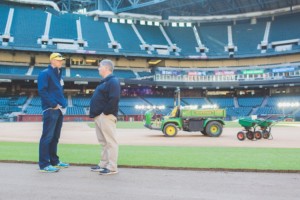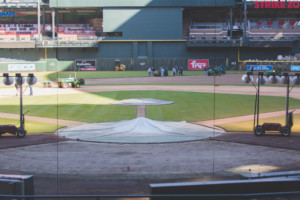Mar
Seashore Paspaulum and Spring Transition for Your Warm Season Lawn
Arizona Diamondbacks
As many of you know BOBSod has been the turf of choice for the Diamondbacks since its conception in 1998, but this year we made a change. The Diamondbacks grounds crew experimented with a few different varieties over the last year and they decided to make the change to the environmentally friendly Platinum TE seashore paspalum. While the BOBSod is still performing at an extremely high level, a shift was made to go with a grass that could be installed without overseed in early March. For those not familiar with paspalum one of its best attributes is its shorter dormancy period. Paspalum can handle temperatures that drop into the 40’s at night before losing color while bermudagrasses will start to lose color in the 50’s. This often leads to a 3+ weeks longer season in the fall and can often green up a few weeks earlier in the spring.
Having the roof over Chase Field provides a lot shade during the spring transition and can really extend the life of the ryegrass. As you probably have learned from your bermudagrass lawns over the years shade will take out your grass over time. Since the ryegrass can live longer inside the stadium, it makes for a longer transition. With this in mind the groundskeeper decided to make the choice to use a non overseeded grass and avoid any transition.
Paspalum has gained in popularity in Arizona and California over the last 10 years because of its ability to tolerate high levels of sodium in the water and soil. Many developments, golf courses, and fields have turned to effluent water and with this there is a large increase in the amount of salt dumped onto the grass with each irrigation cycle. Managing salts can be done with the right nutrients but extreme levels can cause desiccation in grass. Paspalum thrives off clean water, but it can maintain its plant strength in high salt conditions.
For those interested I highlighted some additional attributes of paspalum below. You can purchase paspalum sod in Arizona and California. Please call our office for availability.
• Uses 66% less nitrogen during the growing season compared to bermudagrass
• Has a dark green color and stripes when mowed
• Very high salt tolerance
• Shorter dormancy period than bermudagrass
• Excellent drought tolerance
• Full sun to moderate shade but does perform well under low light conditions such as rain, smog, or fog.
As the temperatures begin to rise it’s a good time to look at your lawn program. Do you have an overseeded lawn, or is your lawn starting to bounce out of dormancy (jump to the bottom of the page for a dormant lawn)? Either way there are some important items to remember so you have a healthy, lush lawn all year long. It’s still a little early to see the full effects of transition but if you plan right your transition will be seamless. Transition typically occurs in April and May but being proactive now can speed up the process. For anyone that’s gone through a spring transition you’ve probably learned the worst mistake is to start too late.
Here is a step by step process that can be implemented into everyone’s program over time. Some people fear putting down an overseeded lawn at this time of the year but there is no need to worry. The roots of the ryegrass actually help the grass knit into the ground quicker and as the temperatures warm up the ryegrass easily transitions out. I will note that you don’t want to buy sod with 3” ryegrass but we keep our turf at ½” to ¾” at this time of the year so it makes for an ideal transition without any fuss.
1. Gradually lower you’re mowing heights to reduce the turf canopy. Warm Season grasses are not shade tolerant and excess ryegrass provides shade. No need to scalp the lawn, just lower the height down and begin to thin out the grass.
2. Lightly verticut the lawn to open up the canopy and let sunlight into the grass below.
3. Be careful of fertilizer rates at this time of the year and stick to slow release products such as Soil Burst 4-4-2, 11-52-0, 6-20-20, or 21-7-14. You want to put a pound of nitrogen per 1000 SF down when you make this fertilizer application. The first number on the bag is Nitrogen and it is listed as a percentage. For example the 21-7-14 is 21% nitrogen. A typical fertilizer bag weighs 50 lbs so 21% of the 50 pounds is nitrogen. In other words you have 10.5 pounds of nitrogen in a 50 lb bag. Since the goal is apply one pound of nitrogen you would use the following formula.
1 pound of Nitrogen / .21 (percentage of nitrogen on the bag) = 4.76 pounds of product per 1000 SF will yield 1 pound of nitrogen.
4. If you have standing water it is a great time to aerify so you can help air and water better infiltrate the soil.
5. Increase your mowing frequency to two times per week.
6. Gradually back off the water next month to stress out the ryegrass when soil temperatures reach 64 degrees (usually around mid April). Turning off the water completely will stress out the warm season turf and ryegrass so this is not the optimal approach. Use 60% of your normal water rate.
7. When soil temperatures reach 64 degrees apply Soil Burst 4-4-2 at 15 pounds per 1000 SF to give the grass a jump start on the year. A second option to this is to use Ammonium Sulfate 21-0-0 at 5 pounds of product per/1000 SF.
8. Fertilize with 1-2 pounds of nitrogen per 1000 SF monthly over the summer. You can use any combination of the products I listed above as well as several others to help you achieve your goal of a perfect lawn. For a more accurate analysis on other nutrients you can send soil samples into a lab for results.
Once you’ve followed all of these steps you can set your irrigation to run 3 to 4 times per week for 20-30 minutes at a time. If you can’t water for 30 minutes without getting runoff it is okay to break it up into a cycle/soak.
Non Overseeded Lawn
By now you’re probably tired of seeing the yellow/brown turf and want to give your lawn a jump start. While it’s still too cool outside to get your lawn growing, you can get it to green up. The enemy of a dormant lawn is the cool nighttime temperatures. A couple weeks ago we received some pretty good freezes which sent any green tissue in the lawn right back into dormancy. At this point we’re likely in the clear from a freeze and you can gradually begin to ramp up your water and fertilizer program.
Let’s start with how much water you need to put on your lawn. The soil temperature is still cool enough that watering 1-2x per week for 10-15 minutes is plenty. It’s good to keep the roots nice and moist and allow the plant to start to thrive but overwatering right now has potential to cause disease in your lawn. When the daytime temperatures get into the 90’s you can increase to 2-3x times a week and slowly ramp up to 3-4x a week by May.
Bringing the grass out of dormancy can be accomplished several ways but I like to do so with products such as 11-52-0, 15-15-15, or Soil Burst 4-4-2. Putting down excessive nitrogen right now will not benefit your bermudagrass since it’s not warm enough to actively start growing. These products will help green up your lawn and slowly bring it back without a jolt of nutrients. Adding too much fertilizer could put the lawn in shock if we were to experience one additional cold snap over the next month. You don’t want the grass to use all of its reserves in the plant too early only to get shocked by some cold weather.
If you want to heat up the soil temperature this can be accomplished with foliar applications of iron or Endurant turf paint to trap the heat in the ground. You often see this done with tarps or blankets on professional sports fields but these products have a similar benefit since most of us do not have turf blankets.
Be sure to check all of your sprinklers and spray patterns. There is a good chance some sprinklers broke and nozzles were damaged over the winter. These are very simple fixes and can be done for just a few dollars. Having the correct spray pattern and coverage can save you money all year long.
If you have any questions please let me know.
Jay



